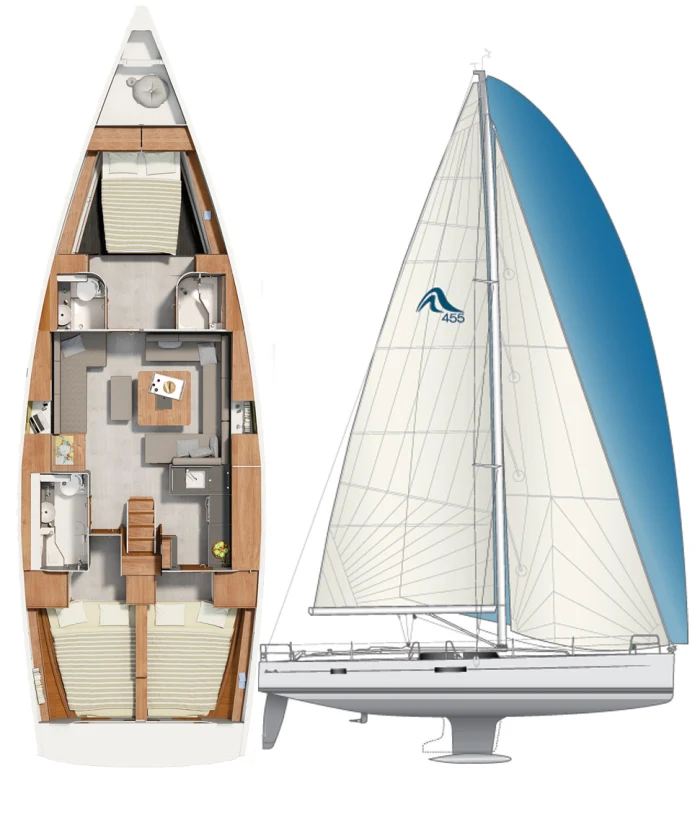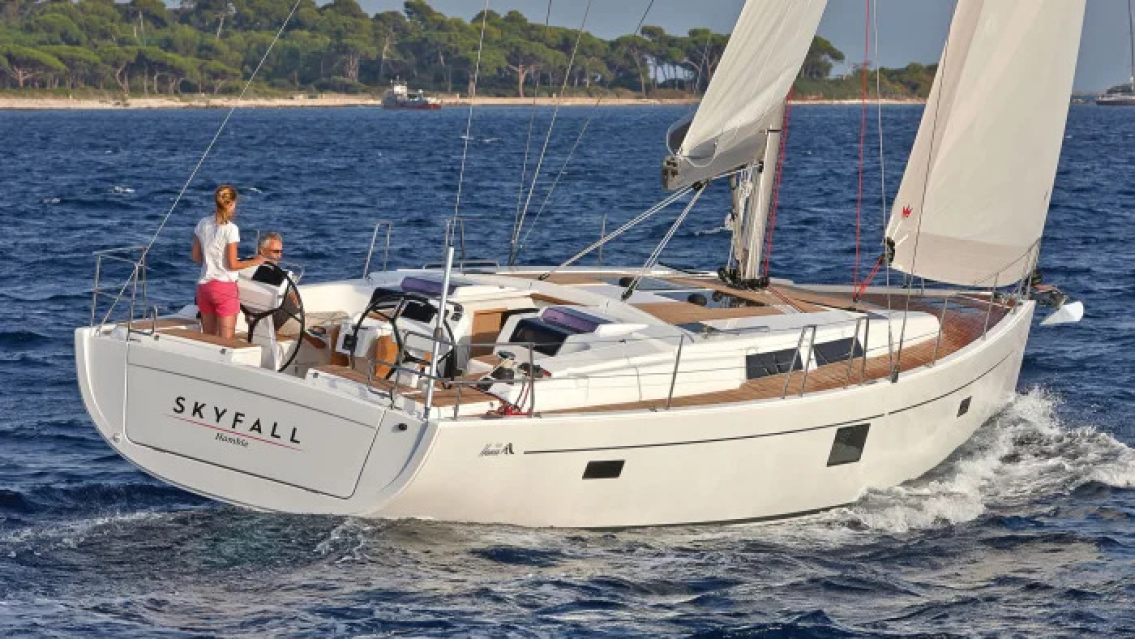Originally published September 1, 2015
Adam Cort - Sail Magazine
The mark of a good boat is not how well it performs when all is well, but when it or its skipper is under some kind of stress. I’m not talking about killer gales here, but the run-of-the-mill sort of stress that can turn an otherwise fun day on the water into something bad—say, an ugly encounter with a piling, or a sudden gust of wind that scares the bejesus out of your less experienced crew.
I found myself entertaining such thoughts during a recent test sail of the new Hanse 455 on Narragansett Bay. It was a perfect day, with a crisp 10-knot breeze blowing out of the southwest. As we made our way south, though, the wind built steadily the closer we got to the Newport Bridge.
All of a sudden, we were hit with a gust just north of Gould Island: not the kind of gust that puts either the boat or crew in any real danger, but still strong enough to cause many performance-cruisers to round up and worry any newbies aboard.
The 455, though, just kept plowing ahead closehauled, pretty as you please. The helm loaded up a bit more than might be ideal, but the rudder never came close to breaking loose—even after I steered down a few degrees to see how the boat responded to my loading up the rig some more. In retrospect, we probably should have flattened the main, but aboard a boat that takes as good care of its crew as the 455 does, it’s easy to become lazy—exactly what you want in a cruiser.
CONSTRUCTION
A product of Hanse’s large, highly efficient manufacturing facility in Greifswalk, Germany, the 455 is similar to the rest of the company’s extensive product line, both in terms of styling and construction.
In appearance it shares the business-like squared-off bow and transom and low, severely angled cabintrunk that have become the company’s trademark—an aesthetic that I, for one, like. In terms of construction, the boat’s hull consists of a solid polyester laminate with a vinylester outer layer to resist osmotic blistering. A structural fiberglass grid is tabbed in place to carry the boat’s keel and rig loads. Bulkheads are also tabbed in place to stiffen the hull, and the deck is balsa-cored to help lower the boat’s center of gravity.
A cast-iron L-shaped 7ft 4in keel is standard. A shoal-draft keel drawing 5ft 8in is also available, as is a high-aspect T-keel with a fairly large ballast bulb, also drawing 7ft 4in. The boat’s tapered double-spreader Seldén aluminum rig is slightly fractional to provide breathing room for an A-sail. Standing rigging is stainless wire.
The boat is equipped with twin Jefa helms and a single deep rudder—another hallmark of the Hanse line and a handy thing to have, whether you’re maneuvering in a crowded marina or muscling your way through a stiff breeze the way we did on our test sail.
ON DECK
On deck you’ll find plenty of room for trimming sails or lounging about. The Hanse 455’s cockpit is large enough that it can accommodate a good-sized folding table and still be easy to get around. All sheets and halyards are led aft to the twin helms, and each helm has a large dedicated bench seat well forward of the split backstay, so you don’t have to worry about the latter digging into your shoulder when you’re sitting to windward steering on a beat.
Practical options abound, including retracting mooring cleats, primary Lewmar winches positioned where you can work them easily from the wheel, a handy slide-away companionway hatch and a massive sail locker accessed through an overhead hatch in the foredeck. Especially fun are the cockpit sink under the portside helm seat and a grill under the helm seat to starboard. Both can be tended with ease, either from the cockpit or from the very large drop-down swim platform. A low bulwark/toe rail provides added security moving forward.
An LOA of 45ft aboard a modern cruising boat means lots of volume for accommodations, and on the Hanse 455 there’s plenty of room, indeed. This is especially apparent in the saloon, which is suffused with ambient light thanks to a plethora of overhead hatches and hull windows.
As on other Hanses, the interior of the 455 is divided into three separate sections fore and aft that can be varied to suit an owner’s particular needs. Aboard our test boat, there was a single, large double berth forward in the owner’s stateroom, and twin double bunks in the mirror image quarterberths aft. I especially liked the side-by-side overhead hatches forward, which let in scads of light and ensure plenty of ventilation on a hot day.
As is the case topsides, there are many nice practical touches, including a dinette table that is as useful folded up as it is unfolded, allowing you to maximize the amount of open space when feeding only a couple of guests. There’s also a handy little storage area in the hinged centerline bench seat, a small nav-station seat that folds up when not in use, and a clever little storage compartment alongside the companionway steps for keeping small items out of the weather when you’re out on deck. The L-shaped galley is equipped with an Eno cooker and Isotherm fridge, and not surprisingly offers plenty of counter space.
UNDER SAIL
Sailing on a beat or close reach aboard the 455 proved to be a piece of cake, thanks to its well-designed rig, keel and rudder. Aboard our test boat (which carried the shoal keel) we easily managed 6.2 knots in just under 9 knots of wind at a 50-degree true wind angle, with our speed jumping to 7-plus knots in the gusts. Thanks to the boat’s self-tacking jib—another Hanse trademark—coming about couldn’t have been simpler. In fact, the boat is so responsive you have to be careful not to bring her around too quickly: a testament to the efficiency and power of her underwater appendages.
Multiple sail options are available, including standard Dacron sails, a performance-cruising “Fast Cruising Laminate” package and a performance package, all built by Elvstrøm. Our test boat flew the performance-cruising sails, with a full-batten main dropping into a Doyle StackPack. In-mast furling is also available, although it would be a shame to compromise the boat’s otherwise great sailing qualities by going this route.
Of course, the downside to a self-tacking rig can be a lack of power off the wind. But aboard our test boat this was easily cured with an A-sail on a Seldén continuous-line furler tacked to the end of the anchor roller. We tended this sail with a pair of secondary Lewmar winches mounted on the cockpit coaming. Gybing downwind off Goat Island we easily hit 8 knots with the apparent wind just aft of abeam, and held onto 6.5 knots on a broad reach even as the wind started to fade.
UNDER POWER
Our test boat was powered by the optional 72hp Volvo auxiliary diesel engine spinning a three-blade Flexofold prop. This proved plenty strong enough to get the boat going 4 knots into a stiff headwind at just 1,000 rpm. Increasing the revolutions to 2,000 rpm yielded 7.5 knots of speed, and at 2,500 rpm we did an impressive 8.6 knots.
Even more impressive was the way the boat’s owner, Derek Hausladen, was able to hold position between a pair of uncomfortably close docks in a stiff crosswind while we waited for a trawler to pass by on our way out. Talk about a potentially stressful situation. The boat, however, did everything he asked of it—backing down and then bumping up to windward a bit before we got going again—even without the optional bow thruster.
CONCLUSION
If I was prone to negativity, I might say that sail-trialing Hanses is becoming a bit of a bore. They are all so consistently well-made and well-mannered under sail. However, as anyone with even a passing understanding of boatbuilding knows, these qualities only come as the result of a lot of hard design work. I have therefore come to look forward to sailing Hanses whenever I get the chance, though whichever one I sail next will have a tough act to follow.
LOA 45ft 7in
LWL 40ft
Beam 14ft 4in
Draft 5ft 8in (shoal); 7ft 4in (std and T-keel)
Displacement 25,570lb; ballast 7,716lb
Engine Volvo 53hp (std)
Fuel (GAL) 58
Water (GAL) 118
Sail Area 1,111ft²
Ratio Ballast 30%
Designer Judel/Vrolijk & Co.
Builder Hanse, Greifswald, Germany
U.S. Distributor Hanse North and South America, Newburyport, MA, 978-239-6568,
AIR DRAFT 67ft 6in (std rig)Ratios: SA/D RATIO 21 D/L RATIO 178


